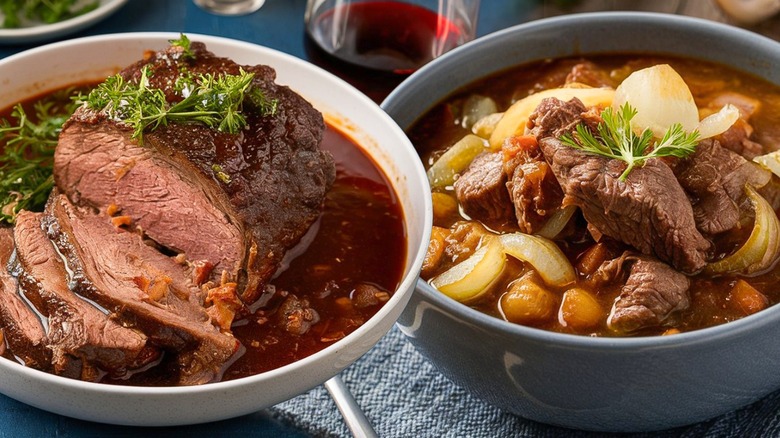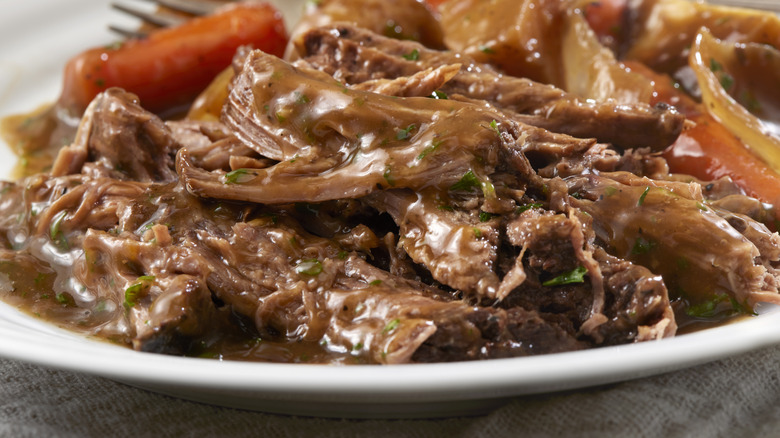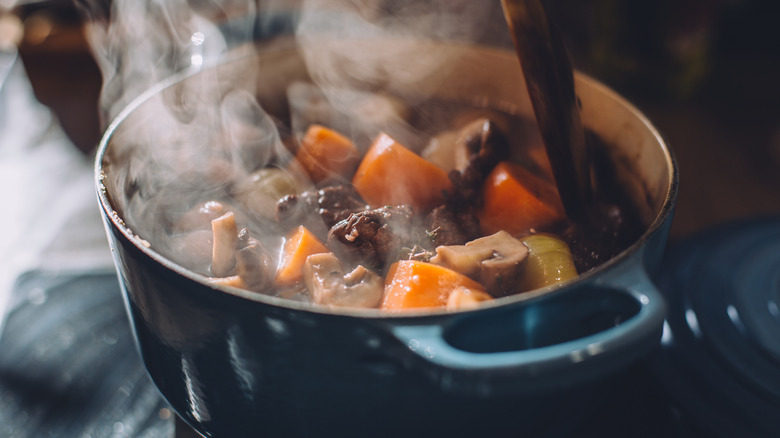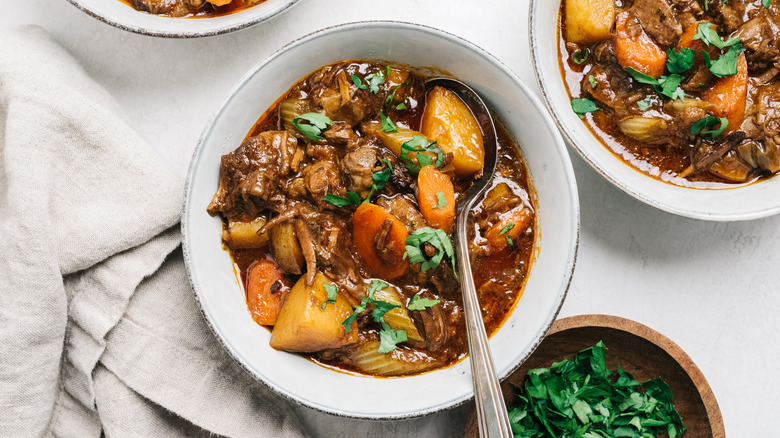Pot Roast Vs Beef Stew: What's The Difference?
When colder weather rolls around, foodies begin thinking about their go-to warming comfort foods. For meat eaters, there's a pretty good chance that pot roast and beef stew are near the top of the list. Both dishes make knockout fix-it-and-forget-it meals for busy weeknights, and can also feed a crowd for stress-free hosting. Although, even to diehard fans, the distinction between these dishes is "stewed" at best. What exactly makes pot roast different from beef stew?
These hearty comfort food classics are all about tender beef, soft vegetables, and fragrant herbs. Chuck roast is the ideal cut of beef for both dishes thanks to its toughness (which holds up well to the long, slow cook time), generous fat marbling, beefy flavor, and affordability. This cut comes from the front shoulder of the steer. However, this cut is more important for pot roast; any boneless beef round steak will work for beef stew. Why? In pot roast, the meat is served in large slabs, while in beef stew, the meat is pre-cut into bite-sized cubes — and that's just the beginning of the differences between these two unique (yet highly similar) dishes.
What is pot roast?
Pot roast lovers might criticize this description as a vast oversimplification, but pot roast is essentially a large cut of meat slow-roasted with vegetables, and sliced into slabs to serve with veggies plated on the side. It's assembled in a casserole dish or Dutch oven, and braised in the oven around 275 to 325 degrees Fahrenheit until fork tender. This can take anywhere from two to four hours depending on the cooking method and weight of the roast. You can cook pot roast in an oven, on the stove, or in a slow cooker or pressure cooker like an Instant Pot. Whichever way you choose, the meat's tough connective tissue needs enough time to melt.
The "pot roast" umbrella refers as much to the actual meat as to the medley of softened vegetables cooked in the pot alongside the roast, which typically includes carrots, onions, and potatoes. Other pot roast veggies could include cubed butternut squash, parsnips, mushrooms, pearl onions, or celery. Aromatics like thyme and rosemary are common, as well as added moisture components like extra beef broth and red wine. There are plenty of less-common ingredients that can take your pot roast to the next level, as well; we're all about pot roast cooked with sweet figs or spicy harissa. To complete the meal, pair your sliced pot roast slabs with a side of aioli-chive mashed potatoes and a full-bodied red wine like a cabernet sauvignon or merlot.
What is beef stew?
Beef stew is cubed beef mixed with equally bite-sized chunks of toothy veggies, all bound together by a thick broth-sauce hybrid (like pretty much every binding agent that falls under the "stew" category). Like pot roast, beef stew's ingredients list reads beef, thyme, rosemary, red wine, potatoes, and carrots. Other beef stew veggies can include peas, onions, potatoes, cremini mushrooms, and celery. Unlike pot roast, extra moisture elements such as Worcestershire sauce, tomato paste, and sometimes beef stock are added to the stew to form the broth-sauce. Since this is a stew, which is by nature simmered in a pot to assemble, beef stew is also typically flavored with bay leaves, an aromatic absent from pot roast. You could also amp up the flavor of your tried-and-true beef stew with avant-garde ingredients like apple cider or fresh ginger.
Beef stew begins on the stovetop and ends in the oven, and compared to pot roast, it involves one extra step: The raw beef is cut into bite-sized cubes, which are then dredged in a thin coating of flour and sometimes a ground spice like paprika or garlic powder. The coated beef cubes are then browned in hot oil on the stove before being added in with the rest of the stew ingredients to braise together, which takes around two to three hours in an oven at 300 degrees Fahrenheit. Alternatively, some foodies prefer to sear their beef before cubing.
Beef stew is a hearty soup and pot roast is a plated entree
Despite their nearly identical ingredients lists, the primary and most immediately apparent difference between pot roast and beef stew is the size and shape of the meat. Pot roast is cut into slabs to serve, then plated with veggies, whereas beef stew is already cut into bite-sized cubes of meat stewed with vegetables and scooped into a bowl to serve. Beef stew is commonly eaten with a fork and contains a greater moisture element compared to pot roast, which is served as a fork-and-knife entree on a plate.
Their distinction comes down to the beef size and the level of moisture content. But, neither pot roast nor beef stew would be possible without braising — the cooking method used to create both of these dishes. Braising is all about long, slow, moist heat, and it might take a little longer than hungry foodies would prefer, but it's essential for tenderizing tougher cuts of meat (the foundation of both pot roast and beef stew). Enter: collagen. Beef is roughly 60-70% water, which means that if you cover the roast as it cooks, the pot roast will cook in its own abundant juices for a succulent bite. As it cooks, the collagen fibers and fat in the meat cook down and are released into the veggies, creating the savory flavor and crave-able richness that make pot roast and beef stew such enduring favorites.



